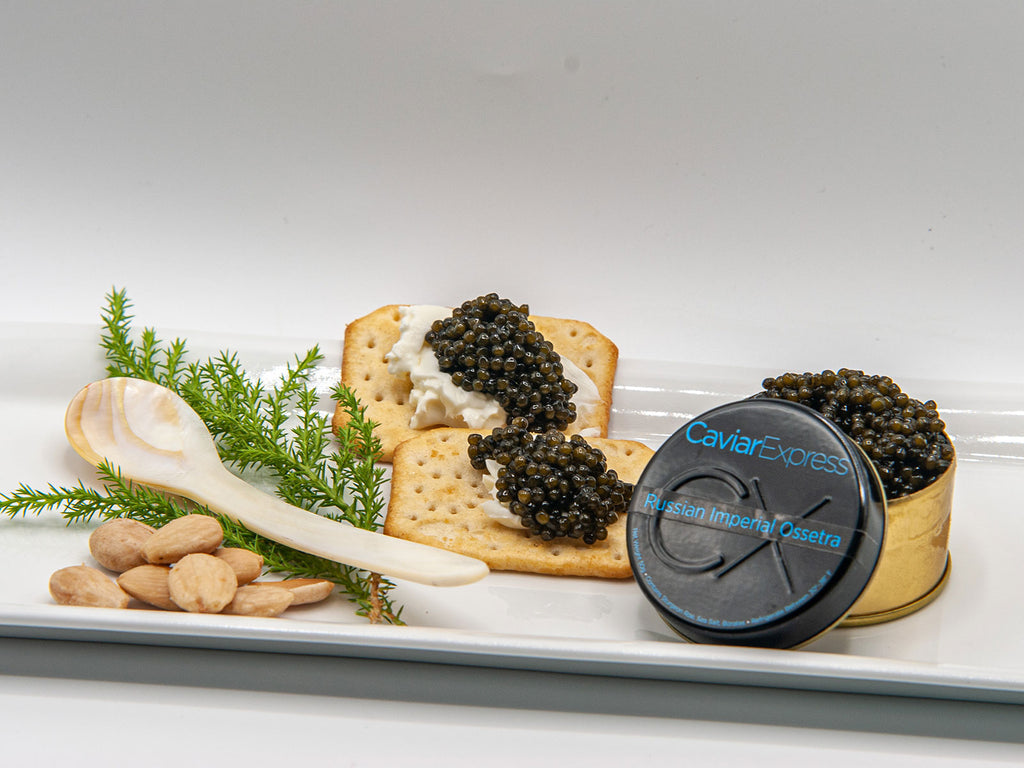What Does Color Reveal About the Caviar?
Caviar is known for its luxurious and distinct flavors, textures, and appearance. The color of caviar can vary depending on the species of sturgeon, its diet, and processing methods. Typically, most consumers associate caviar with black or red, which is a mistake.
A brief overview of these variations:
- Sturgeon Caviar: In earnest, only caviar from the Sturgeon Family should be called caviar... everything else is just roe.
- Beluga Caviar: This type of caviar is usually the largest and comes from the beluga sturgeon. The eggs are typically light to dark gray or black, and offer a unmistakable buttery taste.
- Ossetra Caviar: Osetra caviar comes from the ossetra sturgeon. The eggs can range from amber to dark brown or black, and have a nutty flavor.
- Sevruga Caviar: Sevruga caviar comes from the sevruga sturgeon and is typically smaller in size compared to beluga and ossetra. The eggs are generally black, and a bit saltier than the ossetra.
- Red Caviar:
- Unlike sturgeon caviar, red caviar is not derived from sturgeon but from salmon or trout roe. The eggs are orange to red in color. Red caviar has a distinct flavor compared to traditional sturgeon caviar and is far less expensive.
- Other Colors:
- Caviar can also come in shades such as brown, green, or even a combination of colors. These variations can be influenced by factors such as the sturgeon's diet and the processing methods used.
Shades of black
 Russian Ossetra caviar and Iranian Karaburun caviar can have different hues
Russian Ossetra caviar and Iranian Karaburun caviar can have different hues
Some of the best caviars in the world comes in different "shades" of black. Often times they vary from "silvery" in appearance to "grey" in hue. Typically, the lighter the grey tone, and more reflective and "silvery" in texture, the more mature the sturgeon producing the caviar is. Generally speaking caviar produced by said sturgeon are of higher quality and more uniform in size and firmness.
What about green?
A sturgeon's diet can potentially affect the color of the roe it produces. Although green is usually not a dominant or primary color of fine caviar produced by sturgeon, it can be a good indication it's diet was rich in vegetables, or that the sturgeon was younger when harvested.
Warmer, earthy color variations

The brown, earthy tone of Russian Imperial Ossetra caviar
Besides black and shades of grey, the most common hue associated with true caviar are typically the warmer, earthy colors. Colors such as dark amber, gold, or brown mixed in with black or shades of grey. These colors are not usually associated with quality or taste, but with the specific breed of sturgeon and the processing of their roe. You'll find our Russian Imperial Ossetra caviar to commonly exhibit that golden glow and can vary from a dark brown to jet black in appearance.
Yellow or light gold in hue
True caviar in a yellow or golden hue without the black or grey base color are rare indeed. These are produced by albino strains of the Sterlet sturgeon. Because of the rarity of albino sturgeons, and the small, delicate nature of the roe produced by the smaller Sterlet sturgeons, yellow or golden caviar is truly the rarest of rare delicacies and can demand a hefty price. Some other albino sturgeon can also produce caviar of a golden hue. Since the color variation is produced by the lack of pigmentation, these caviar may not taste that much different from their normal counterpart.
In conclusion
It's worth noting that the trade and harvesting of certain types of sturgeon for caviar have faced environmental concerns, leading to efforts to promote sustainable caviar production and consumption. When purchasing caviar, it's advisable to choose products from reputable sources that adhere to sustainable practices.
If you want to find out more about how to select the best caviar, read our blog "A Guide to Identify High-Quality Caviar" here.
